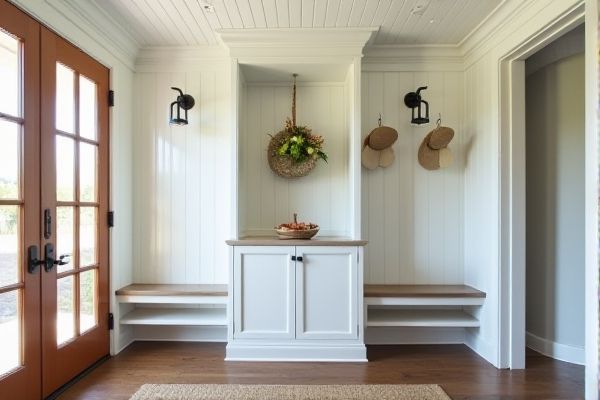
Mudroom beadboard ceilings offer a classic, textured look with narrow, vertical planks that create a charming, cottage-style ambiance, while tongue and groove ceilings provide a seamless, smooth finish ideal for a modern or rustic aesthetic. Discover which ceiling option best suits your mudroom's style and functionality by reading the rest of the article.
Table of Comparison
| Feature | Mudroom Beadboard Ceiling | Tongue and Groove Ceiling |
|---|---|---|
| Material | Pine, MDF, or PVC panels with narrow vertical grooves | Wood or engineered wood planks with interlocking tongue and groove joints |
| Appearance | Classic, cottage-style with closely spaced beaded lines | Seamless, smooth surface with visible plank lines |
| Installation | Simple nailing or adhesive; easier alignment | More precise fitting required; interlocking boards snap together |
| Durability | Moderate; susceptible to moisture damage unless treated | High; solid fit reduces warping and gaps |
| Maintenance | Requires regular cleaning and occasional repainting | Minimal; can be stained or sealed for longevity |
| Cost | Generally lower cost due to simpler materials | Typically higher due to material and installation complexity |
| Best Use | Ideal for casual, rustic, or vintage-style mudrooms | Suitable for sleek, modern, or traditional designs |
Introduction to Mudroom Ceiling Options
Mudroom ceiling options commonly include beadboard and tongue and groove, each offering distinct aesthetic and functional benefits. Beadboard ceilings are characterized by narrow, vertical planks with repetitive grooves, creating a classic, cottage-style charm while enhancing durability against moisture. Tongue and groove ceilings feature interlocking boards that provide a seamless, sturdy surface ideal for rustic or modern farmhouse designs, often preferred for their structural integrity and ease of installation.
What is a Beadboard Ceiling?
A beadboard ceiling features narrow, vertical planks with distinctive, evenly spaced grooves or "beads" that create a textured and charming look ideal for mudrooms. This design enhances your space by adding a classic, cottage-style aesthetic while hiding imperfections and offering durability. Compared to tongue and groove ceilings, beadboard tends to have a finer, more detailed pattern that works well for small mudrooms requiring a cozy, inviting atmosphere.
What is a Tongue and Groove Ceiling?
A tongue and groove ceiling features interlocking wooden boards designed to fit snugly together, creating a seamless and durable surface ideal for mudrooms. This method prevents gaps and adds structural stability, enhancing the ceiling's aesthetic with a classic, linear pattern. Choosing a tongue and groove ceiling for your mudroom ensures long-lasting beauty and easy maintenance compared to beadboard alternatives.
Visual Appeal: Beadboard vs Tongue and Groove
Beadboard ceilings in mudrooms create a classic, textured look with narrow, vertical grooves that enhance charm and brightness. Tongue and groove ceilings offer a more polished, seamless appearance with wider planks that emphasize natural wood grain and craftsmanship. The choice between beadboard and tongue and groove influences the overall aesthetic, with beadboard providing a cottage-style feel and tongue and groove delivering a rustic or contemporary elegance.
Installation Process Comparison
Mudroom beadboard ceilings offer a straightforward installation process with lightweight panels that easily fit into existing joists, making them ideal for DIY projects. Tongue and groove ceilings require precise alignment and secure fastening of interlocking boards, which can demand more time and skill, especially in uneven or irregular spaces. Both options provide durable, moisture-resistant finishes but beadboard typically allows faster installation due to its modular design.
Durability and Maintenance
Mudroom beadboard ceilings offer moderate durability with a textured surface that can hide minor dents but may require regular painting to maintain its appearance. Tongue and groove ceilings boast superior durability due to their interlocking design, creating a tighter, more stable structure that resists warping and moisture damage better. Your choice impacts maintenance needs: beadboard often demands more frequent touch-ups, while tongue and groove ceilings provide long-lasting resilience with minimal upkeep.
Cost Differences
Mudroom beadboard ceilings typically have a lower material and installation cost compared to tongue and groove ceilings due to their simpler design and thinner planks. Tongue and groove ceilings often require more precise craftsmanship and higher-quality wood, which can increase both labor and material expenses. When budgeting your mudroom renovation, choosing beadboard can save money while still offering a charming, textured ceiling option.
Insulation and Acoustic Properties
Mudroom beadboard ceilings offer modest insulation and moderate sound absorption due to their thinner profile and less dense material, making them suitable for decorative purposes but less effective for noise reduction. Tongue and groove ceilings, constructed from interlocking boards, provide better thermal insulation and superior acoustic dampening by minimizing gaps and creating a tighter seal. Your choice between beadboard and tongue and groove ceilings will significantly impact the thermal comfort and sound control in your mudroom.
Best Design Styles for Each Ceiling Type
Mudroom beadboard ceilings complement cottage, farmhouse, and coastal design styles, adding a charming, textured look that emphasizes rustic and casual aesthetics. Tongue and groove ceilings suit traditional, craftsman, and modern farmhouse interiors, offering sleek, linear patterns that create a polished and structured feel. Your choice between these ceiling types should align with the overall design theme to enhance the room's character and cohesion.
Choosing the Right Ceiling for Your Mudroom
When choosing the right ceiling for your mudroom, beadboard offers a classic, textured look that complements traditional and cottage styles, while tongue and groove provides a sleek, continuous finish ideal for modern or rustic designs. Beadboard panels are typically narrower with vertical grooves, enhancing a room's charm and light reflection, whereas tongue and groove boards interlock for a seamless, sturdy surface that hides nail holes and imperfections. Your choice depends on the desired aesthetic, durability needs, and how the ceiling integrates with the overall mudroom design.
 homyna.com
homyna.com